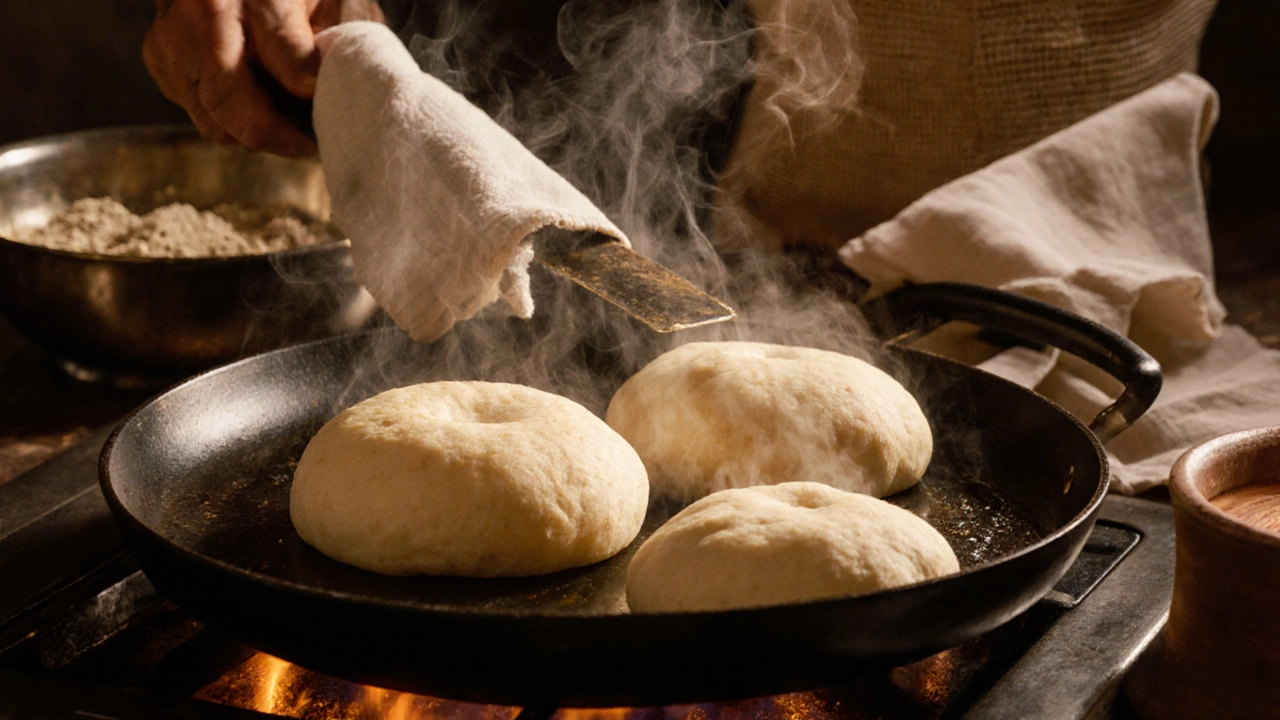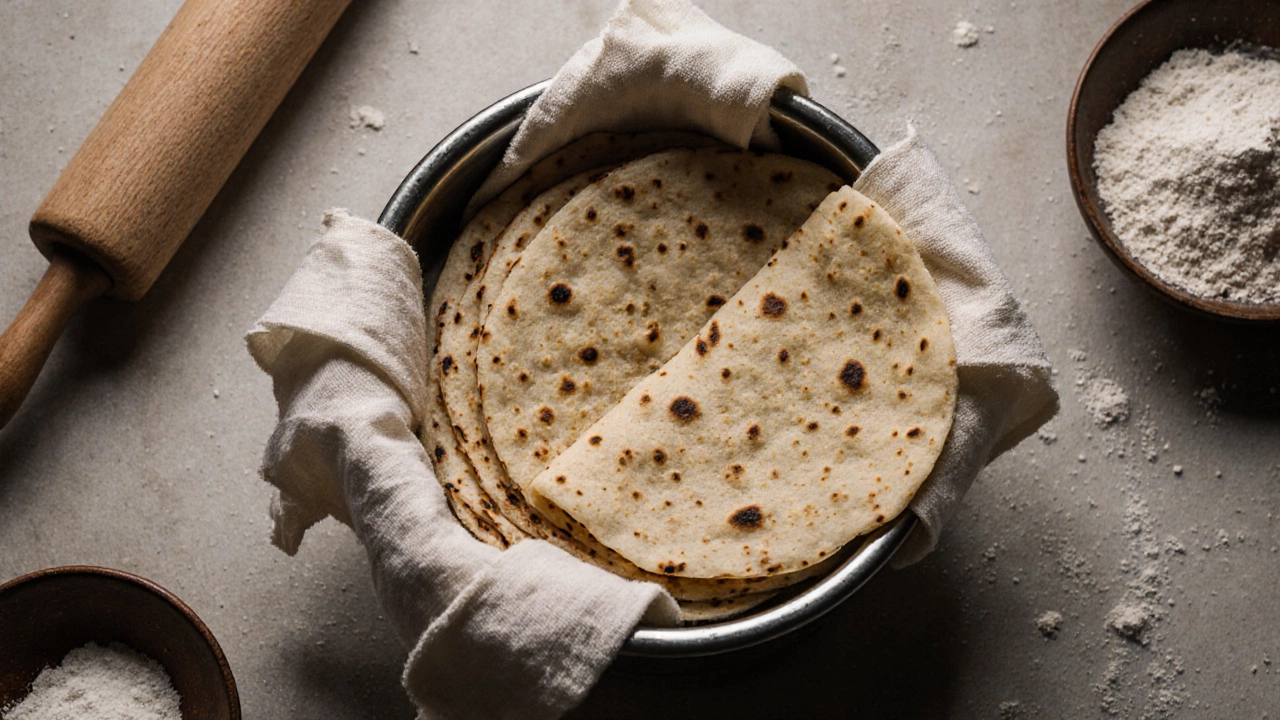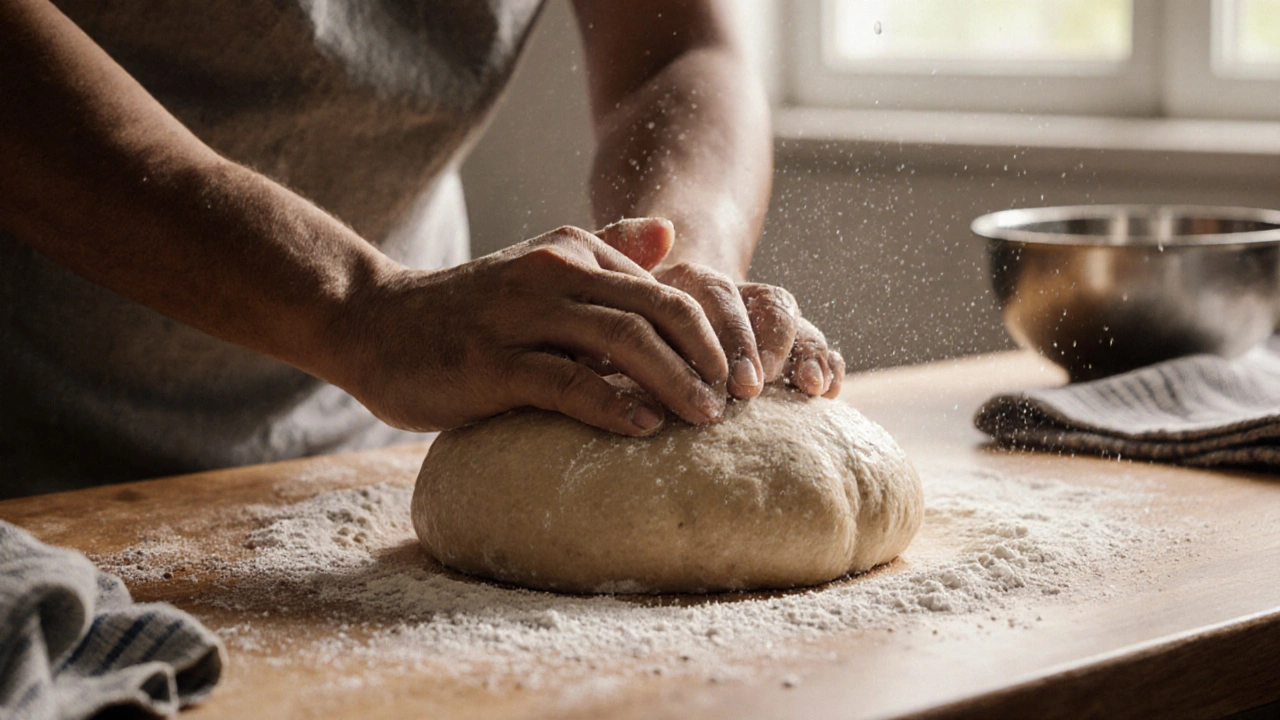28 Oct 2025
- 0 Comments
Roti Troubleshooter
Why Are Your Rotis Hard?
Select the symptoms you're experiencing to get personalized solutions based on 7 common mistakes.
Symptoms
Select all that apply
Recommended Solution:
Select your symptoms to see your personalized solution.
Ever roll out your roti dough, cook it on the tawa, and end up with a hard, dry disc instead of a pillowy, pliable roti? You’re not alone. Even experienced cooks struggle with this. Soft rotis shouldn’t be a mystery-they should be easy, consistent, and comforting. But too many people skip the basics and wonder why their rotis turn out like cardboard. The problem isn’t your recipe. It’s the process.
The Dough Is Too Dry
Most rotis fail because the dough doesn’t have enough moisture. You see a recipe that says "2 cups flour," so you measure it exactly and add water until it looks "right." But flour absorbs water differently depending on humidity, brand, and even how long it’s been sitting on the shelf. In Sydney’s dry winter air, flour can be extra thirsty.
Start with 1.5 cups of water for 2 cups of whole wheat flour (atta). Mix it slowly. The dough should feel slightly sticky at first-that’s okay. Knead it for at least 8 minutes. You’ll know it’s ready when it’s smooth, elastic, and doesn’t crack when you pinch it. If it feels dry and crumbly, sprinkle water a teaspoon at a time while kneading. Don’t rush this step. Dough that’s too dry won’t trap steam when cooking, and that’s what makes rotis soft.
You’re Not Resting the Dough
Skipping the rest time is the #1 mistake. After kneading, cover the dough with a damp cloth and let it sit for at least 30 minutes. Better yet, leave it for an hour. During this time, the gluten relaxes and the flour fully hydrates. Without rest, the dough springs back when you roll it, making it thick in spots and thin in others. That uneven thickness means some parts cook too fast and dry out.
Try this: make your dough before you start cooking. While it rests, prep your vegetables, set the table, or clean up. When you come back, the dough will be easier to roll, softer to press, and will puff up beautifully on the tawa.
Your Tawa Isn’t Hot Enough
A cold or lukewarm tawa is the silent killer of soft rotis. You need medium-high heat-not smoking, but hot enough that a drop of water sizzles and evaporates instantly. If the tawa is too cool, the roti takes too long to cook. It dries out before it puffs. If it’s too hot, it burns before the inside gets steamy.
Test your tawa: sprinkle a few drops of water. If they dance and vanish in under 2 seconds, you’re good. If they just sit there, wait longer. Preheat your tawa for at least 5 minutes before you start rolling. And don’t oil it. A dry, clean tawa is key. Oil creates a barrier that stops steam from forming inside the roti.

You’re Not Cooking It Right
Roti doesn’t cook evenly if you flip it too early or too often. Place the rolled roti on the hot tawa. Wait until you see small bubbles forming on the surface-about 30 seconds. Then flip it. Let the second side cook for 15-20 seconds. Now, lift it with tongs and press gently on the surface with a clean cloth or spatula. That’s when steam builds up and makes it puff up like a balloon.
If it doesn’t puff, don’t panic. Flip it back, press again, and hold it over direct flame for 5-10 seconds. That’s the trick used in Indian homes: direct flame contact finishes the puffing. You don’t need a gas stove-just hold it over the heating element of your electric stove, or use a handheld torch if you’re serious about perfect rotis.
You’re Not Keeping Them Warm
Once cooked, rotis start to lose moisture the moment they hit the air. If you stack them cold, they get firm fast. After cooking each roti, immediately place it in a clean, dry cotton cloth or a thermal container. Wrap them loosely-don’t seal them tight. The trapped steam keeps them soft for hours.
Use a steel or ceramic tiffen box with a lid. Line the bottom with a cloth, stack the rotis, cover with another cloth, and close the lid. This method keeps rotis soft even after 4-5 hours. No microwave. No plastic wrap. Just cloth and heat retention.

You’re Using the Wrong Flour
Not all whole wheat flour is the same. Regular whole wheat flour from the supermarket (often labeled "wholemeal") is ground too finely and lacks the fiber and protein structure needed for soft rotis. You need atta-specifically stone-ground, coarse whole wheat flour made for Indian breads.
Atta has more bran and germ, which holds water better and gives the dough elasticity. If you’re using regular whole wheat flour, your rotis will be dense and crumbly no matter how hard you try. Look for brands like Aashirvaad, Pillsbury Atta, or any Indian grocery store brand labeled "roti atta." If you can’t find it, mix 80% whole wheat flour with 20% all-purpose flour to add some softness-but atta is still the gold standard.
You’re Rolling Too Thin or Too Thick
There’s a sweet spot. Too thick, and the center stays doughy. Too thin, and it crisps up like a cracker. Aim for about 6-7 inches in diameter and 1-2 mm thick. Roll evenly from the center outwards. Don’t press hard on the edges-leave them slightly thicker. That’s where the steam gets trapped to make the roti puff.
Pro tip: use a rolling pin with a slight curve. It helps you roll evenly without thinning the edges. If your roti keeps tearing, your dough needs more rest or more water. Don’t patch it with flour-that just makes it dry.
Soft rotis aren’t luck. They’re the result of attention to detail. Moisture, rest, heat, and technique-all matter. Get one thing right, and your rotis improve. Get all seven right, and you’ll never go back to hard, dry ones again.
Why do my rotis crack when I roll them?
Cracking usually means the dough is too dry or hasn’t rested long enough. Add a teaspoon of water and knead for another minute. Then let the dough rest for at least 30 minutes. If it still cracks, your flour might be too fine or low in protein. Switch to proper roti atta.
Can I make roti dough ahead of time?
Yes. You can make the dough up to 24 hours in advance. Cover it tightly with plastic wrap or a damp cloth, then refrigerate. Let it come to room temperature for 1 hour before rolling. Cold dough is harder to roll and won’t puff as well.
Should I add oil or ghee to the dough?
Not for traditional rotis. Oil or ghee makes the dough greasy and prevents it from puffing properly. Save oil for parathas or stuffed rotis. For plain rotis, stick to flour and water only. The softness comes from steam, not fat.
My rotis puff up but still feel hard. Why?
That means they’re losing moisture after cooking. Make sure you’re wrapping them in a clean cotton cloth immediately after they come off the tawa. Don’t leave them uncovered on the counter. Even a few minutes of exposure to air will dry them out.
Can I use a pressure cooker to cook roti?
No. Pressure cookers trap steam and cook food evenly, but rotis need direct, dry heat to puff. A pressure cooker will steam the roti instead of cooking it on a tawa, making it soggy and dense. Stick to a tawa or skillet for authentic results.
How do I know if my atta is good quality?
Good atta has a slightly gritty texture-like fine sand, not powder. It should smell earthy and nutty, not musty. When you knead it, it should feel springy and hold together without crumbling. If it feels too fine or dusty, it’s likely processed too much and won’t make soft rotis.
